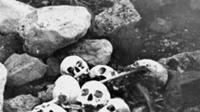 Exactly what happened to the ill-fated Franklin expedition remains a mystery. in 1845, Captain Sir John Franklin, with a crew 129, attempted to traverse the last unnavigated section of the Northwest Passage and never returned. Some of the bodies expedition crew have been found but the wrecks of the two ships, Erebus and Terror have never been located despite a century and a half of searching. What is fascinating about the story is that parts of the mystery as to what happened to the expedition have appeared to have been solved several times, only to have new findings debunk the previous explanation. A new study suggests that the current theory of the failed expedition may also be flawed.
Exactly what happened to the ill-fated Franklin expedition remains a mystery. in 1845, Captain Sir John Franklin, with a crew 129, attempted to traverse the last unnavigated section of the Northwest Passage and never returned. Some of the bodies expedition crew have been found but the wrecks of the two ships, Erebus and Terror have never been located despite a century and a half of searching. What is fascinating about the story is that parts of the mystery as to what happened to the expedition have appeared to have been solved several times, only to have new findings debunk the previous explanation. A new study suggests that the current theory of the failed expedition may also be flawed.
In 1984, three bodies of Franklin’s sailors where exhumed from a grave on Beechey Island. All three corpses were found to have high levels of lead in their bones. While lead poisoning did not kill the sailors, the high levels might explain some of the weakness and irrational behavior evidenced during the expedition. The initial source of the high lead levels was identified as the solder on poorly made food cans. Further analysis suggests that there was not enough lead in the cans to have caused the observed lead in the sailor’s bones.
Next, the hot water system on the ships was singled out as the culprit. Now however, chemists at the University of Western Ontario have concluded there was so much lead in the bones, and it was distributed so widely, that it couldn’t have accumulated during the few months the men were at sea before they died.
“The wide distribution and high concentrations of lead in the measured bones is indicative of long-term exposure before the start of the expedition,” says Professor Ron Martin, who recently published a paper on their findings. Martin’s team concludes that if Franklin and his men were poisoned by lead, it probably began long before they set sail for what is now the Canadian Arctic.
“We’ll probably never know what happened to the crew of the Franklin [expedition], so it will remain one of the great mysteries of Canadian history,” said Professor Martin.
Thanks to Alaric Bond for passing the story along.

Why such a harsh term in reaction to this study. A definition of debunk is,
DEBUNK: to expose the pretension or falseness of, esp by ridicule.
I would have thought at that time there was a high lead content in many things and it could have affected these seafarers. It seems a reasonable factor to be considered. At least surely it could be considered a contributing factor to their deaths by causing them to be the weaker members of the expedition. As a child my parents made me aware of the dangers of lead poisoning because paint and many other things still had a high lead content.
Good Watch.
Debunk may be a touch harsh. Nevertheless, finding the high lead levels was considered a very neat explanation for some of the more bizarre elements of the Franklin story, as we know it. If the lead was a pre-existing problem, then the what had once seemed a very plausible scenario for the reports of unexplained illness and some rather odd choices made by survivors, all goes away. The mystery, which many had thought at least partially solved, is as mysterious as ever.
Greetings,
The following is taken from the Project Gutenberg copy of Francis Leopold McClintock’s book, In the Arctic Seas: A Narrative of the Discovery of the Fate of Sir John Franklin and his Companions. Based on this account, there may only be one ship possible to locate, either the Erebus or the Terror. The possibility of one ship being driven ashore by the ice is quite possible, based on what happened to some of the Arctic whaling ships on the north coast of Alaska during the 1870s, when they were caught by pack ice.
“After much anxious inquiry we learned that two ships had been seen by the natives of King William’s Island; one of them was seen to sink in deep water, and nothing was obtained from her, a circumstance at which they expressed much regret; but the other was forced on shore by the ice, where they suppose she still remains, but is much broken. From this ship they have obtained most of their wood, &c.; and Oot-loo-lik is the name of the place where she grounded.” (page 228).